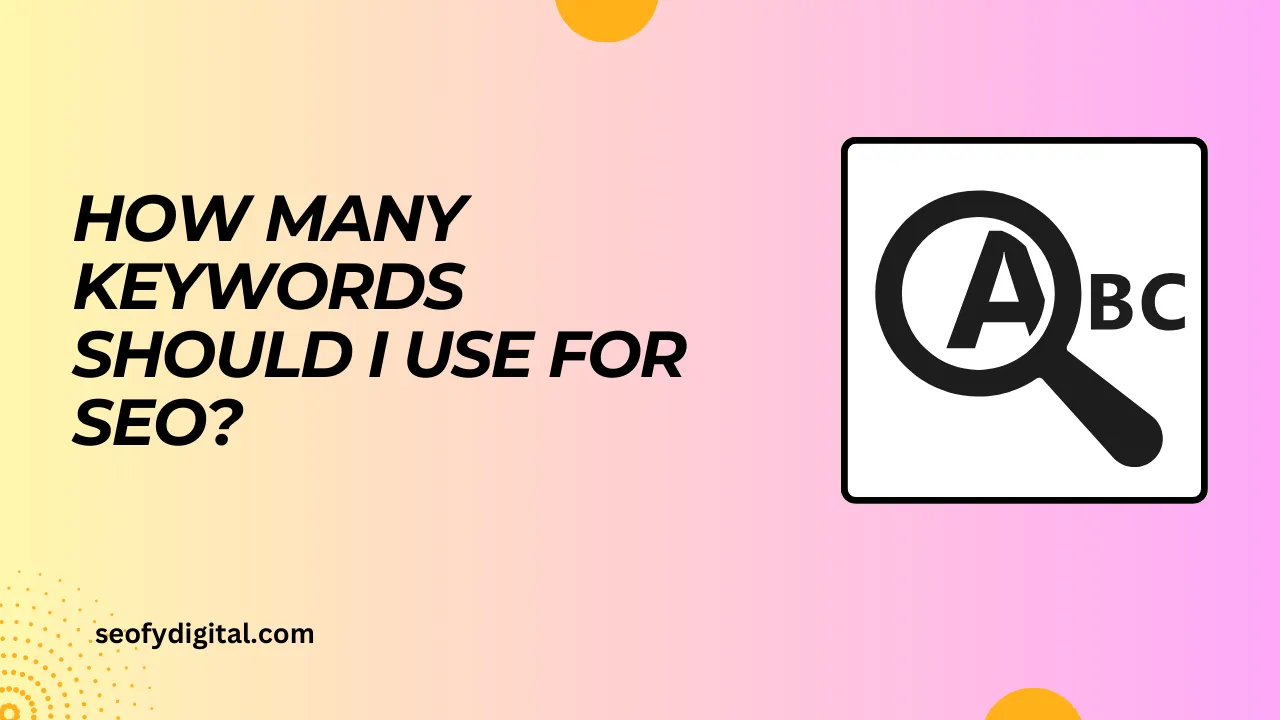In today’s digital world, SEO plays a critical role in driving traffic, improving brand visibility, and growing online presence. One fundamental question that often arises is, “How many keywords should I use on each page to rank effectively?”
For many, the assumption is that more keywords equal better SEO, but this is a misconception. In fact, overloading a page with keywords can actually hurt rankings rather than help them. Modern SEO is not about the quantity of keywords but rather their relevance and strategic placement.
The concept of keyword density—or how many times a keyword appears in your content—used to be a major focus, but search engines have advanced. Google’s algorithms are now smart enough to understand the context, relevance, and natural flow of keywords, rewarding content that reads naturally and genuinely serves user intent.
So, instead of aiming for an arbitrary number, SEO success now depends on well-chosen, high-quality keywords integrated organically within engaging and informative content. In this article, we’ll explore the ideal way to use keywords to optimize SEO without overdoing it.
By understanding keyword research, keyword placement, and the balance between on-page SEO and user experience, you’ll be equipped to make data-driven decisions. Let’s delve into best practices to ensure your SEO strategy is both effective and sustainable.

Contents
Keyword Research and Selection
Understanding Keyword Intent:
- Search intent, or user intent, refers to the purpose behind a search query. There are three main types: informational (seeking knowledge), transactional (intent to buy), and navigational (looking for a specific site).
- Matching keywords with search intent ensures your content aligns with what users want. For example, an e-commerce page might target transactional keywords, while a blog post might focus on informational keywords.
Using Keyword Research Tools:
- Tools like Google Keyword Planner, SEMrush, and Ahrefs provide insights into keyword volume, competition, and potential ranking difficulty.
- High-volume, low-competition keywords are ideal targets, as they’re more likely to attract traffic with less competition. These tools also help identify related keywords or LSI (Latent Semantic Indexing) keywords, which enhance content without overloading it with repetitions of the main keyword.
Keyword Difficulty and Relevance:
- Keyword difficulty measures how hard it is to rank for a keyword based on the competition. High-difficulty keywords are challenging to rank for, while low-difficulty ones are easier, especially for newer sites.
- Long-tail keywords (specific multi-word phrases) are usually less competitive and attract targeted traffic. For example, instead of using “SEO tips,” a long-tail keyword could be “SEO tips for small businesses,” targeting a more specific audience.
Keyword Placement and Density
Natural Keyword Integration:
- The goal is to write engaging content that flows naturally, with keywords appearing organically rather than feeling forced. This ensures your content reads well and aligns with search engine guidelines.
- Keyword stuffing—the practice of overusing keywords—should be avoided as it disrupts the readability and can lead to penalties from search engines.
Strategic Keyword Placement:
- Place primary keywords in title tags, meta descriptions, headings, and introductory paragraphs to help search engines identify the focus of the page.
- Effective title tags are concise, clear, and contain keywords. Meta descriptions should also be persuasive while incorporating relevant keywords. Using headers (H1, H2, H3) for keywords enhances the organization and readability of the content.
Keyword Density and Balance:
- Instead of aiming for a specific keyword density, focus on clarity and relevance. There’s no fixed “magic number,” so prioritize quality. Include variations and synonyms to avoid redundancy, making the content more comprehensive and natural.

Keyword Optimization and Tracking
On-Page SEO Optimization:
- Beyond keywords, on-page SEO includes elements like URL structure, image alt text, internal linking, and site architecture. Including keywords in URLs can help reinforce the page’s topic, while alt text ensures images contribute to the SEO value.
- Using internal links strategically can also support SEO, as it guides users to other related content and improves site navigation.
Off-Page SEO and Backlinks:
- Backlinks from high-authority sites signal to search engines that your content is credible and relevant. This can boost your domain authority and keyword rankings.
- Building backlinks involves creating shareable, quality content that other sites find valuable. Social media sharing also contributes indirectly by driving more traffic to your site.
Keyword Tracking and Analysis:
- Google Analytics and Google Search Console are essential tools for tracking keyword performance. They provide insights into traffic, bounce rates, and keyword performance.
- Regularly reviewing keyword analytics helps you make data-driven adjustments. For example, if a keyword isn’t performing well, you may choose to optimize the content further or add related keywords.
The Role of User Experience
Page Speed and SEO Impact:
- Page load time is a ranking factor; slow-loading pages deter users and increase bounce rates. Compressing images, using efficient coding practices, and caching can significantly boost load speeds.
- Faster pages create a smoother user experience, which in turn improves engagement metrics.
Mobile-Friendliness and Accessibility:
- With Google’s mobile-first indexing, websites optimized for mobile devices rank higher in search results. A responsive design is essential to ensure that content displays well on all devices.
- Ensuring accessibility for all users, including those with disabilities, enhances usability and aligns with Google’s accessibility standards.
Content Quality and Engagement:
- The value of high-quality, relevant content cannot be overstated. Engaging, well-researched content that answers user questions keeps visitors on the page longer, signaling to search engines that the content is valuable.
- Write compelling and informative content that naturally incorporates keywords, making it valuable to users and search engines alike.
Conclusion
Effective SEO relies on the right balance of keywords rather than the sheer volume of them. By focusing on quality keywords and strategic placement, you create content that appeals to both users and search engines.
Emphasizing user experience—from page speed to mobile-friendliness—supports your SEO efforts by making your site a place where users want to stay and explore. As search engine algorithms evolve, adaptability is key.
Regularly updating keyword strategies, tracking performance, and optimizing content ensures sustained growth and relevance. Instead of being keyword-heavy, concentrate on creating reliable, well-researched content that naturally meets user needs. Implement these practices, and you’ll be well on your way to achieving SEO success.
FAQs
1. How many keywords should I focus on per page?
Aim for one primary keyword and two to three secondary keywords that enhance the page’s relevance without overwhelming it.
2. What happens if I use too many keywords?
Overusing keywords, known as keyword stuffing, can lead to penalties and damage readability, driving users away.
3. How do I know if a keyword is too competitive?
Use tools like Ahrefs or SEMrush to check keyword difficulty scores; a higher score means more competition.
4. Is keyword density still important?
Instead of a strict density, prioritize natural keyword use that supports the readability and relevance of content.
5. Can I rank for the same keyword on multiple pages?
You can, but it risks keyword cannibalization where pages compete against each other. Try using variations or different keywords.
6. What’s the benefit of long-tail keywords?
Long-tail keywords target specific audiences with less competition, leading to higher conversion rates.








